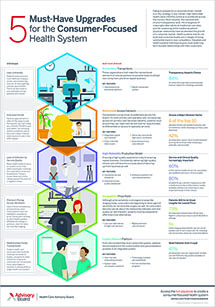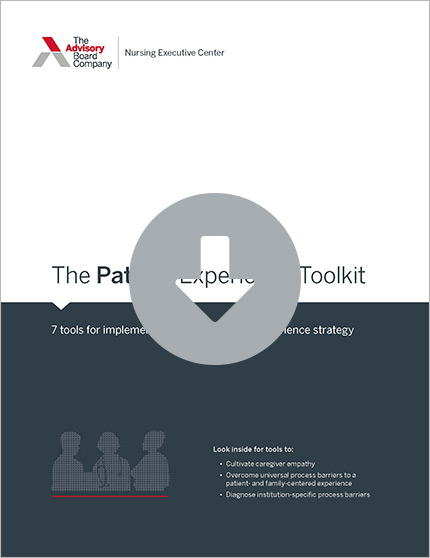Auto logout in seconds.
Continue LogoutEditor's note: This popular story from the Daily Briefing's archives was republished on Sept. 28, 2020.
Hospitals are notorious for disturbing sleeping patients for testing, but waking patients can cause negative health effects, Austin Frakt writes in the New York Times' "The Upshot."
7 tools for implementing a holistic patient experience strategy
'A terrible way to start recovery'
Vitals checks and lab tests are part of any hospital stay, but the frequency of the interruptions are not necessary for all patients and can greatly reduce the amount of time that patients sleep, according to Frakt.
Peter Ubel, a physician with Duke University, recalled numerous interruptions for vitals checks, lab tests, blood draws, and loud machines when he stayed at a hospital after surgery in 2013. "Not an hour went by without some kind of disruption. It's a terrible way to start recovery," he said.
According to Harlan Krumholz, a physician at Yale University, these checks can "caus[e] harm by ignoring the important restorative powers of a healing environment."
For example, Frakt writes sleep interruptions can worsen a patient's "posthospital syndrome," which he defines as "the period of vulnerability to a host of health problems after hospitalization that are not related to the reason for that hospitalization." Specifically, the disruptions can lead to hypertension, mood disorders, or reduced immune function in patients, Frakt writes.
Krumholz said, "[T]he key to a successful recovery after illness may be a less stressful, more supportive, more humane experience during the hospitalization."
How hospitals are working to reduce disruptions
According to Frakt, some hospitals are taking steps to minimize disruptions and maximize sleep time for patients.
Ubel in 2013 offered a few ways hospitals can make their environments "more conducive to rest." Among other things, he suggested that hospital staff use one visit to perform multiple tests, which could reduce the frequency interruptions, or schedule check-ins based on the patients' needs. For instance, an ICU patient might require check-ins every four hours, while check-ins on low-risk could be performed every eight hours, Ubel said.
According to Frakt, Yale-New Haven Hospital has adjusted their check-in schedule by allowing nurses to create the schedules and ensure tasks are completed before patients go to sleep. Taking patients' needs and schedules into account when scheduling tests and check-ins has been proven to reduce the percentage of patients reporting sleep disruptions, as well as the use of sedatives by 50%, Frakt reports.
Other hospitals are looking to reduce noise as a way to help patients get more rest, Frakt writes. Massachusetts General Hospital installed rubber floors to reduce noise in the facility. University of Michigan Health System similarly installed floor tiles that reduce sound, and adjusted the facility's cleaning schedule to minimize nighttime noise, Frakt reports. Mojtaba Navvab, associate professor of architecture at University of Michigan, said, "[T]he sound level was three times lower" after installing sound-absorbing tiles.
Frakt notes that those seemingly small adjustments can reduce patients' risk of sleep deprivation. He writes, "Being sick and hospitalized is bad enough. Being subjected to sleep deprivation adds insult (or more injury) to injury" (Frakt, "The Upshot," New York Times, 12/3).
7 tools for implementing a holistic patient experience strategy
Even with renewed investment in patient satisfaction, many institutions are struggling to improve, often because they define the ambition too narrowly or pursue a campaign-style approach.
Get 7 tools to help cultivate caregiver empathy, overcome universal process barriers to a patient- and family-centered experience, and diagnose institution-specific process barriers.
Don't miss out on the latest Advisory Board insights
Create your free account to access 1 resource, including the latest research and webinars.
Want access without creating an account?
You have 1 free members-only resource remaining this month.
1 free members-only resources remaining
1 free members-only resources remaining
You've reached your limit of free insights
Become a member to access all of Advisory Board's resources, events, and experts
Never miss out on the latest innovative health care content tailored to you.
Benefits include:
You've reached your limit of free insights
Become a member to access all of Advisory Board's resources, events, and experts
Never miss out on the latest innovative health care content tailored to you.
Benefits include:
This content is available through your Curated Research partnership with Advisory Board. Click on ‘view this resource’ to read the full piece
Email ask@advisory.com to learn more
Click on ‘Become a Member’ to learn about the benefits of a Full-Access partnership with Advisory Board
Never miss out on the latest innovative health care content tailored to you.
Benefits Include:
This is for members only. Learn more.
Click on ‘Become a Member’ to learn about the benefits of a Full-Access partnership with Advisory Board
Never miss out on the latest innovative health care content tailored to you.


